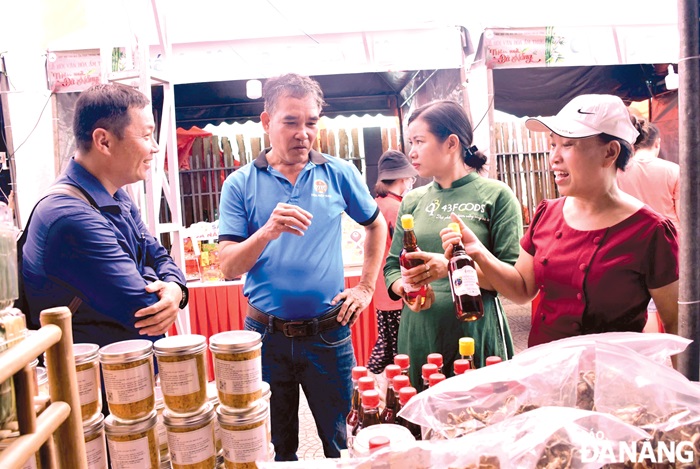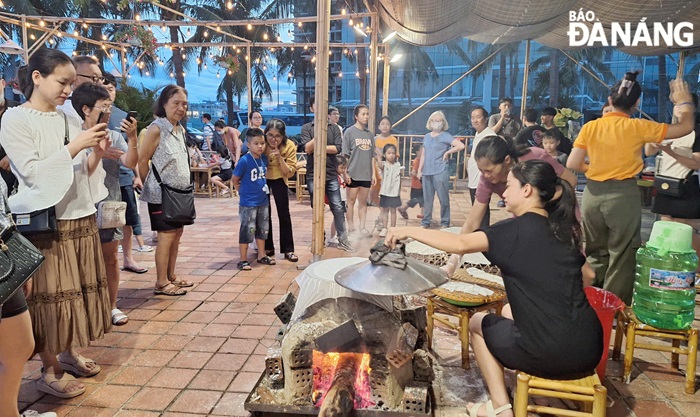Intangible cultural heritage is considered extremely valuable resources of each country and region, with special appeal to attract domestic and foreign tourists. Currently, Da Nang is home to 7 national intangible cultural heritages that have been preserved and conserved in the locality.

Nam O fish sauce is displayed and introduced at the event Man ma Da Nang taking place in April 2024 to promote to tourists. Photo: Thu Ha
Developing tourism products associated with cultural heritage
The city’s 7 intangible cultural heritages, included in the List of National Intangible Cultural Heritages, are Quang region's Tuong (classical drama) art form, Non Nuoc stone carving village, Nam O fish sauce making craft, Cau Ngu (Fish Worshipping) Festival, Bai Choi (singing while acting as playing cards), Quan The Am (Avalokiteśvara) Festival, and Tuy Loan rice paper making craft.
Among these heritages, there are three traditional crafts: Nam O fish sauce making craft, Non Nuoc stone carving craft, and Tuy Loan rice paper making craft. They are great advantages for Da Nang in building experiential tourism products associated with traditional craft villages.
Mr. Bui Thanh Phu, the owner of the Huong Lang Co fish sauce making facility in Hoa Hiep Nam Ward, Lien Chieu District, feels very happy at the recognition of the city's cultural heritages as national intangible ones, including traditional craft villages.
According to Mr. Phu, like other traditional crafts, the Nam O fish sauce making craft carries great cultural value. Those who are working, maintaining and developing the craft in Nam O Village are hoping for more policies and strategies from the municipal authorities to further develop craft village. They also stressed the need for the local tourism industry to create conditions for fish sauce making households in Nam O Village to have more spacious spaces to welcome large groups of visitors to visit and experience.
Mr. Phu highlighted the importance of developing the craft village into a tourism product in not only enhancing the quality of people's life, but also supporting business households in having more motivation to preserve, maintain and develop the craft village.
Sharing the same point of view, Mr. Luu Van Tam Anh, Head of the Management Board of the Non Nuoc Stone Carving Village, said that to promote the development of the village, stone carving establishments in the village have all applied modern technology in manufacturing and design. With the desire to bring the quality products far and wide, many young people have boosted self-study to promote production in a professional and methodical direction in order to increase the value of stone art products and create attractiveness for visitors to visit and experience.
In the coming time, the craft village will improve the environment and greenery, speed up the construction of a traditional house where products will be displayed, and develop tours by electric car or walking to serve tourists.

Tourists experience making Tuy Loan rice paper at the 'Enjoy Da Nang' Festival 2024. Photo: Thu Ha
Promoting values of heritage
According to Mr. Nguyen Ngoc Thien, Deputy Director of the Hai Van Cat International Travel Company, Da Nang has 7 heritages included in the list of national intangible cultural heritages, which is very valuable resources and documents for the tourism industry. This is a foundation for people working in the tourism sector to build related tourism programmes and products, such as cultural, heritage and historical tourism.
The close combination of culinary culture and local culture not only brings economic benefits but also contributes to preserving and promoting traditional cultural values, thereby creating an attractive destination for tourists, especially international travellers.
In recent times, the city's cultural and tourism sectors have organised many activities to introduce intangible cultural heritage products to people and tourists, such as the regular performances of ‘bai choi’ and Tuong, the maintenance and development of the Cau Ngu and Quan The Am festivals, and the promotion of traditional craft villages at major events and festivals.
Chairman of the Da Nang Tourism Association Cao Tri Dung said that the 7 heritages are extremely valuable for the city's tourism in developing cultural tourism and exploiting indigenous cultural values to enrich the destination ecosystem. This is the missing piece of the local tourism, complementing the products that the city is targeting for.
Although the tourism products associated with indigenous culture of Da Nang are still modest, if combined with the 7 existing heritages, they will create a premise for tourism to develop indigenous culture.
Mr. Dung, however, stressed the necessity for relevant departments and agencies, businesses and local communities to be able to form new products.
He suggested the city choose heritages that can be combined with natural cultural values, nature, and other infrastructure to form clusters of tourism products. For example, the Tuy Loan rice paper craft village can be combined with routes for river tourism, or combined with visiting communal and ancient houses, and vegetable villages. The visit to Nam O fish sauce making village can be combined with Hai Van Gate sightseeing tour. Only when tourism products associated with the values of craft villages, the value of these heritages can be effectively tapped, he emphasised.
Reporting by Thu Ha - Translating by M.Dung